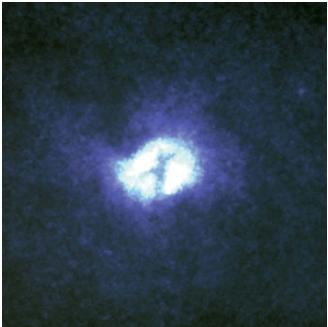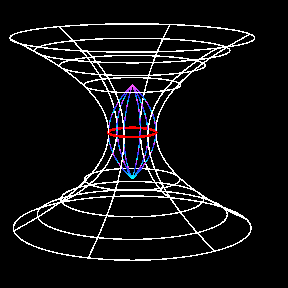
What is a Black Hole?
A black hole is created when a star undergoes a supernova explosion that leaves stellar remnant. Since there is nothing to oppose gravity, the stellar remnant collapses inside of itself. A singularity is created which means that the star now has no volume but an infinite density. This density continues to increase as light rays bend and wrap around the star and a black hole is born. These black holes are atleast 10 to 15 times larger than the size of the Sun. Matter is sucked into a black hole when it crosses the Schwarzschild radius. This radius is where the escape speed is equal to the speed of light. Anything that enters cannot leave, even light.
Types of Black Holes


- Stellar Black Holes - This type of black hole is created from stars. Stars need an equal balance of pressure and gravity to exist. When a star runs out of nuclear fuel, which is used to heat the stellar interior, gravity takes control. The outer interior will explode into a supernova and the interior will begin to implode. This causes a black hole to develop depending on whether the central core is massive enough.

- Supermassive Black Holes - Astronomers believe that this type of black hole is created when anything approaches the event horizon and circles the black hole in the accretion disk. This causes the mass of the black hole to increase more and more creating a supermassive black hole.
- Miniature Black Holes - There is no sure evidence that this type of black hole exists. Astronomers believe that if they do exist, they were created right after the Big Bang and have event horizons as big as the width of an atomic particle. It is believed that miniature black holes hold the same amount of matter as Mount Everest.
How to Detect a Black Hole
Because black holes suck in everything that goes past the Schwarzschild radius, including light, it might seem impossible to see and detect them. However, there are four ways astronomers have found to aid them in detecting a black hole.
- When a star colapses and becomes a black hole, it still has the same gravitational field. Any planets or bodies orbiting the star will continue to orbit the black hole. Thus, the planets will appear to be orbiting around nothing. They could be orbiting around a star too faint to see, or they could be orbiting around a black hole.
- Black holes have a large amount of dark masses in a small volume. They can be detected by measuring the amount of dark mass in an area. If there is a large amount of dark mass in a small area, it is plausible that the area consist of a black hole.
- Gravity Lensing also helps to detect a black hole. When a black hole moves between the Earth and a star, the black hole acts as a lens. Its gravity bends the stars light rays and focuses them on Earth. To an observer from Earth, the star would appear to brighten.


(Gravity Lensing)
- Because of the intense gravity of a black hole, dust particles from near by stars are pulled in. When the dust particles speed and heat up, they emit x-rays. These x-rays can be detected by an x-ray telescope outside of the Earth's atmosphere.
Facts About Black Holes
- Astronomers believe that a new black hole forms every day.
- The closest known black hole to the earth is 1,600 light years away.
- The Milky Way galaxy may contain millions of stellar black holes.
- There is a supermassive black hole at the center of the Milky Way galaxy. It is 4 million times the mass of the Sun, and nearly 30,000 light years away.
Wormhole

A wormhole is the idea that anything that enters a black hole at one end will travel to and out another black hole. This would then cause space travel to other parts of the universe (or other universes) via "shortcuts." Though this is a largely discussed and exciting idea, there is no proof that wormholes actually exsist.

Work Cited:
http://www.dmnh.org/main/en/Professionals/Press/CurrentPressReleases/Press+Releases/Planetarium/blackHolesFactsAndGlossary.htm
http://www.rdrop.com/users/green/school/detect.htm
http://www.crystalinks.com/wormholes.html


Comments (0)
You don't have permission to comment on this page.